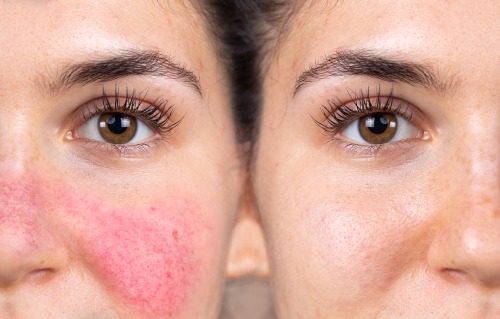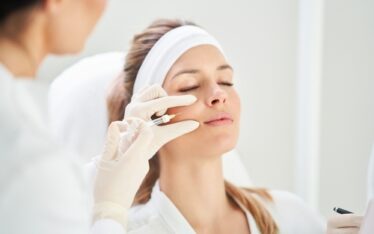Does Rosacea Return After Laser Treatment?

Rosacea is a common skin condition that affects 16 million Americans and many more worldwide. While there isn’t a cure for rosacea, there are several ways to manage its symptoms. Laser therapy is a newer option that shows promising results, offering an alternative to traditional treatment methods, such as surgical intervention or medications.
However, while laser therapy can help address the visible aspects of rosacea, it isn’t a cure. Since rosacea is a chronic condition, the problem may resurface after a time. In this blog, we’ll explore rosacea and laser therapy as a treatment to help you decide if it’s right for you.
Understanding Rosacea
Rosacea is a condition affecting the skin that causes flushing and rosiness on the face. In some individuals, it can cause enlarged blood vessels and small, pus-filled bumps. The severity of the condition varies from one individual to the next, with some experiencing severe symptoms for months while others experience intermittent and mild symptoms.
The rosy appearance, sometimes accompanied by bumps, can be mistaken for other skin problems, such as acne or dermatitis.
Symptoms of Rosacea
While symptoms can vary from one person to the next, those with rosacea may experience various common symptoms, including:
- Visible veins: Rosacea may affect the blood vessels on the nose and cheeks, causing them to break, enlarge, and become visible. For some, the veins may become visible, although they may remain hard to see on certain skin tones.
- Rosiness: Redness and flushing are well-known symptoms of rosacea. However, on certain skin tones, the flushing may appear more subtle, such as a pinkish hue or a deeper purplish color.
- Tenderness: The affected areas may feel like they’re burning, with the skin feeling hot and tender.
- Eye issues: Ocular rosacea, characterized by dry eyes and irritated, swollen eyelids, can accompany other skin symptoms.
- Acne-like bumps: Rosacea can cause pus-filled pimples on the skin that mimic the appearance of acne. These bumps often appear on the face, but they may also appear on the back and chest.
- Thickened skin: With time, rosacea can cause thickened skin on the face, particularly near the nose. The thickened skin can make facial features look larger.
Types of Lasers Used to Treat Rosacea
Historically, doctors have used an assortment of medications to treat rosacea. The condition is incurable, but topical antibiotics, acne drugs, oral antibiotics, and azelaic acid have long been used to treat rosacea and help patients keep it under control.
However, in recent years, doctors have started to use lasers to treat this condition. Like the other treatments, laser therapy doesn’t cure rosacea, but it can help control its appearance.
It’s important to note that laser treatment isn’t for everyone, and it may not be a suitable solution for all rosacea cases. Many patients use it as a last resort, employing its restorative power to minimize the appearance of their rosacea.
If you and your doctor decide laser treatment is a good route, they may use various types of laser treatments, including:
- Ablative lasers, or CO2 lasers, are used to treat bumps and thickened skin associated with rosacea.
- Pulsed-dye lasers are often used to reduce inflammation due to and minimize the appearance of visible blood vessels.
- YAG lasers are often used to target visible blood vessels, but may also help reduce excess tissue and shrink pores.
- Intense pulsed light therapy isn’t technically laser therapy, as it involves wavelengths of light, but it can help smoothen the skin’s hue and reduce redness.
How Effective is Laser Treatment for Rosacea?
Various studies have demonstrated the efficacy of laser treatment for rosacea. While laser studies on rosacea-associated telangiectasia and erythema are limited, studies examining the effects of copper-bromide, krypton, and KTP lasers have demonstrated promising results.
For example, when used to treat visible blood vessels, laser treatment can offer up to a 75% reduction in visible blood vessels within just a few treatments. Some patients may see a 100% reduction.
CO2 (ablative) and pulsed-dye lasers are the most common, both offering decent results. Studies show the results are comparable to partial excision by scalpel or electrosurgery, although the results via laser take longer than conventional surgical methods.
Does Rosacea Return After Treatment?
While many patients notice remarkable progress in their rosacea after several laser treatments, it’s possible for the condition to return once more. Rosacea is a chronic condition, so a few laser treatments may not correct its appearance permanently.
Some patients find that additional laser sessions are necessary in the months and years after the initial treatment.
For example, when used to treat visible blood vessels, the results may last up to five years. While the treated blood vessels don’t reappear, new ones may form and cause the same issues.
Find a Solution to Your Rosacea With Clarus Dermatology
Laser therapy has been shown to be an effective treatment option for reducing the appearance of rosacea. While the results may not be permanent, as rosacea is a chronic condition, laser therapy can provide promising results for those experiencing it.
Of course, it’s important to remember that laser therapy might not be the right fit for all rosacea cases. At Clarus Dermatology, we’re dedicated to helping you find a solution for your rosacea, giving you the tools you need to keep it under control. Whether you’re debating the merits of laser therapy or need help finding an effective solution, our team is here to help.
Ready to book an appointment? Contact us today and schedule an appointment at a location near you!


